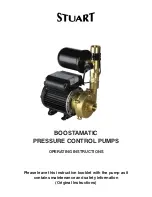
Installation
10
3A8693B
Tips to Reduce Cavitation
Cavitation in a diaphragm pump is the formation and
collapse of bubbles in the pumped liquid. Frequent or
excessive cavitation can cause serious damage,
including pitting and early wear of fluid chambers,
flappers, and seats. It may result in reduced efficiency of
the pump. Cavitation damage and reduced efficiency
both result in increased operating costs.
Cavitation depends on the vapor pressure of the
pumped liquid, the system suction pressure, and the
velocity pressure. It can be reduced by changing any of
these factors.
1.
Reduce vapor pressure: Decrease the temperature
of the pumped liquid.
2.
Increase suction pressure:
a.
Lower the installed position of the pump relative
to the liquid level in the supply.
b.
Reduce the friction length of the suction lines.
Remember that fittings add friction length to the
lines. Reduce the number of fittings to reduce
the friction length.
c.
Increase the diameter of the suction lines.
d.
Ensure the inlet fluid pressure does not exceed
25% of the outlet working pressure.
3.
Reduce liquid velocity: Slow the cyclic rate of the
pump.
Pumped liquid viscosity is also very important but
normally is controlled by factors that are process
dependent and cannot be changed to reduce cavitation.
Viscous liquids are more difficult to pump and more
prone to cavitation.
Graco recommends taking all of the above factors into
account in system design. To maintain pump efficiency,
supply only enough air to the pump to achieve the
required flow.
Graco distributors can supply site-specific suggestions
to improve pump performance and reduce operating
costs.











































